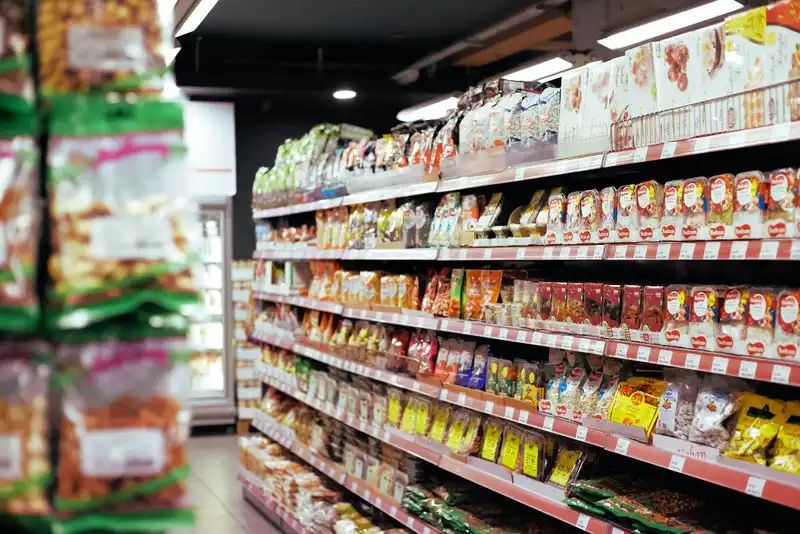The Guide to Food Manufacturing
Introduction to Food Manufacturing
Food manufacturing has been a popular method of producing convenient and accessible food since ancient times. Now, with companies, like General Mills, Frito-Lay, and Tyson Foods, consumers can easily purchase ready-to-eat foods from a local store. In fact, according to Industry Research, the market for processed foods reached $5.9 trillion in 2019. And it is expected to rise to $7.7 trillion by 2026. As more and more people consume manufactured products, it is important to understand their processes.
What is Food Manufacturing?

Food manufacturing refers to transforming raw ingredients into edible products. Companies in the food manufacturing industry produce a wide range of packaged consumer foods. For example, General Mills uses raw materials like wheat, oat, and sugar to make cereals, desserts, and pet food. The food manufacturing value chain also encompasses animal processing, such as butchers and slaughterhouses. The following are common techniques that these businesses use to process their products.
- Cutting - For convenience, food manufacturers will cut or chop vegetables, produce, and meats for consumers. For example, they will peel and can peaches or grind raw beef and put it into packages. People can then save time and make their meals faster.
- Preserving - Proper food preservation techniques will maximize shelf life and conserve flavor. A way to preserve meat, fruits, and vegetables is dehydrating, which is the process of removing moisture from the ingredient. Another method is adding salt or vinegar to food so it can pickle. Many companies are also known for canning ingredients.
- Seasoning - When processing multiple products together, their flavor may change. Therefore, manufacturers will season these foods to help elevate the flavor profiles and quality
- Homogenizing - This method refers to using fat droplets, additives, and stabilizers to ensure components in a product do not separate. Homogenization is common for salad dressings, cream, and milk.
Food Manufacturing Steps
More small businesses are manufacturing food and selling them at farmers' markets and grocery stores. However, to be successful in the industry and to connect to target consumers, proper techniques must be implemented. The following are key steps to food manufacturing.
1. Conduct Industry and Market Research

Entrepreneurs need to perform industry and market research to better understand existing products and potential competitors. Researching will also highlight the costs of making a product, as well as its practicality and demand. This will enable strategic brainstorming on how to boost profits and be innovative.
Research can be done by reviewing public records or talking to business owners in the food industry. Entrepreneurs can also attend trade shows, study food trends, and browse through grocery stores to learn about the market. It is also helpful to test recipes and give samples out to those interested. This will allow the business to have reviews and feedback from consumers about their product.
2. Outline Finances
It is important to outline all expenses that the business will encounter. This includes costs of ingredients, packaging, labels, machinery, and distribution. By identifying costs, the owner can budget and find the right investments. Generally, businesses will accumulate funding from personal capital, or family and friends. They can also use crowdfunding campaigns, like Kickstarter.
3. Create the Right Packaging
Effective product packaging will convey the business's brand and attract consumers to the item. Especially since store shelves will have hundreds of other products, the company will need a label that stands out. One way to create unique and profitable packaging is to understand target consumers. For example, a brand is launching a coffee drink for health-conscious customers. A marketable design may include listing all the health benefits of the product on the label.
4. Ensure Regulatory Compliance

The Food and Drug Administration (FDA) has different regulations for each variety of food products. They also have guidelines on product labeling. Small businesses must make sure their store-ready item meets these federal rules, as well as state regulations. This will reduce the chances of lawsuits or penalties due to non-compliance in the future. Additionally, many grocery stores will only stock products that are FDA-compliant.
5. Protect the Product
As the brand begins to produce large volumes of food for the market, business owners may need to work with more people. This means different individuals will have access to the brands' goods, ideas, and secret recipes. To prevent company information from being shared and replicated, all people associated with manufacturing need to sign a non-disclosure agreement (NDA).
6. Have Marketing Campaigns
A successful marketing plan will allow the brand to reach a wide customer demographic. This will then help boost sales and overall profits. Businesses can develop effective marketing campaigns by performing market research to learn customers' preferences.
Importance of Good Food Manufacturing Practices

Good manufacturing practices, also known simply as GMP, is the process of consistently producing products according to specified quality standards. This involves controlling the manufacturing process and preventing risks, such as cross-contamination and mislabeling. In the United States, companies must also adhere to the Current Good Manufacturing Practices (CGMP), which is regulated by the FDA.
Following GMP is important because it helps assure the product's quality. It also ensures that manufacturing processes and facilities are properly maintained. These measures will enable companies to reduce waste and protect consumers from harm. Additionally, it promotes food safety and accountability.
Difference Between Food Processing and Food Manufacturing
While food manufacturing and food processing both involve producing goods for human consumption, they are two different practices. The following are key points that differentiate food processing and manufacturing.
Food Processing
Food processing refers to first-level manufacturing, in which raw materials in this process are transformed into an ingredient. For example, processors will use tomatoes and make tomato paste or transform vanilla beans into vanilla extract. Then, they package the products into containers and sell them to consumers or manufacturers.
Food Manufacturing

Also known as the second-level manufacturer, food manufacturing companies will make products using the ingredients made by processors. For instance, manufacturers can use the tomato paste and make pizza, or purchase the vanilla extract to make ice cream.
Pros of Food Manufacturing

Food manufacturing makes it easier and accessible to provide food for a growing population. Other benefits to food manufacturing include the following factors.
Improved Control Over Quality
Food manufacturers must follow protocols to ensure cleanliness and quality. These processes entail cleaning storage spaces, cooking foods at the right temperature, and using the right packaging. This ensures that the integrity and flavor of foods are maintained at all times.
Ensured Food Safety Compliance
Along with procedures for quality control, food manufacturers have to ensure food safety compliance. This involves preventing risks and hazards, such as bacterial contamination, from impacting foods and consumers. Food companies in the United States, follow Hazard Analysis Critical Control Point (HACCP) to guarantee food is safe to consume.
Have a Centralized Approach
Manufacturers also have their own procedures and protocols for sourcing ingredients, recipe management, quality control, and preparation. These guidelines will guarantee that all of the company's manufacturing facilities follow the same approach and that the end products are made consistently.
Save Consumers Time
Food manufacturing allows people to minimize their cooking times since the foods are pre-prepared. It also helps those that do not like cooking, have little experience with it, or just need a quick meal on the go.
Cons of Food Manufacturing

Despite the various benefits, there are several drawbacks to food manufacturing. This includes the following factors.
Prevalence of Genetic Engineering
Manufactured foods may oftentimes use genetically engineered ingredients. This refers to crops whose genetic material has been modified to improve yields or taste. Although extensive research has suggested that these products are safe to eat, many people are concerned that they may have harmful long-term effects on the human body.
Lack of Nutrients
Many food manufacturing companies are known for creating foods that lack nutrients. This can be attributed to the fact that mass-produced grains and crops are treated with chemical fertilizers to grow. Without nutrient-rich topsoil, the products will miss out on proper nourishment and minerals.
Negative Health Effects
Many meat manufacturers often feed their animals antibiotics to prevent pathogens from contaminating their stock. Researchers have cautioned that antibiotics in animals can increase the transmission of drug-resistant bacteria to humans. Additionally, some processed foods have added ingredients to increase their shelf life. Over-consumption of these preservatives can result in illnesses, such as high blood pressure, diabetes, and obesity.
Food Manufacturing Technology
To leverage the benefits of food manufacturing and prevent its various drawbacks, companies are investing in the latest technology. These new tools enable brands to be more efficient and health-conscious. The following are 4 top digital solutions that food manufacturers are implementing.
1. Artificial Intelligence (AI) and Robotics
Artificial intelligence is used to command advanced robotics into thinking and acting like humans. Food manufacturing companies will use these technologies to perform repetitive and defined tasks. For example, AI robots can be used to slice meats or package products. This helps the business maintain consistent quality and improves efficiency. It will also promote employee safety and lessen labor costs.
2. Automation

As reported in a 2017 study, 73% of companies in the food manufacturing industry either had or were about to incorporate automation into their processes. Similar to artificial intelligence and robotics, automation helps streamline repetitive tasks. It can improve speed, output volume, and accuracy, as well.
Generally, establishing automation involves setting up software solutions, such as food safety software. Users can then program the system to complete various functions, like track critical food safety tasks.
3. Digital Twins
In the food manufacturing industry, digital twins refer to stimulating copies of a system for testing and analytics. This technology allows business owners to run tests and simulations using real-time data from their operations. They can then gain greater visibility into patterns and trends, as well as forecast future outcomes. This is beneficial for product development, distribution, market research, and product testing.
4. Blockchain

A prominent trend among general consumers is the increased consciousness of food health and sustainability. People want to know that the foods they are eating are safe and healthy and that it was produced using environmentally conscious ways. They also want more clarity into where their foods and ingredients are sourced.
With blockchain technology, food manufacturers can easily trace their products' origin and location. It will also show who tended the crops and what methods they used. Users can also see each step the product went through, from when it was on the farm to the store shelf. This is because blockchain is a digital record book that entities from each stage in the supply chain will add information to. Businesses will also use this technology to track food contamination outbreaks.
Conclusion to Food Manufacturing
- The food manufacturing process is the transformation of raw ingredients into edible end products for human consumption.
- Common food manufacturing techniques include cutting, preserving, seasoning, and homogenizing.
- Small businesses can break into the food manufacturing industry by following 6 key steps.
- Food processing and food manufacturing are two different practices, in that the former refers to producing ingredients. On the other hand, food manufacturing is when the ingredients are transformed into food products.
- To improve efficiency and streamline food manufacturing processes, companies can implement technologies, such as artificial intelligence, automation, and blockchain.
